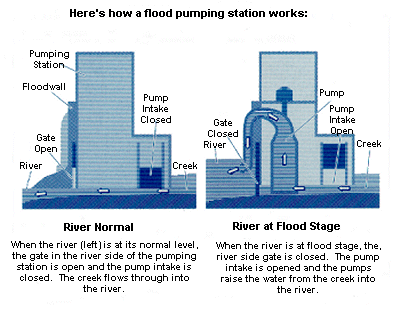The devastation and damage of the 1937 flood worried Louisville for years. Many of these worries were confirmed just eight years later, in March 1945, when Louisville's second-highest flood occurred.
The need for a major flood protection system became obvious in 1937, and planning began not long afterward. But World War II intervened, and major civil works projects were delayed. Construction finally began in 1948, under the U.S. Army Corps of Engineers.
|
Cost of Operation and Maintenance Floodwall maintenance and operations are financed through the drainage fees collected by MSD. Flood protection expenditures will consume approximately 23% of drainage revenues in FY 2007. When a flood occurs, the costs increase — depending upon the length and severity of the flood. MSD's 1993-1994 budget for flood protection includes: |
|
| Maintenance and Testing: | |
| Floodwall, Pumping Stations and Gates | $ 1,201,400 |
| Construction: | |
| Stormwater Construction & Repair | $5,610,800 |
| Total: | $6,812,200 |
The system is designed to deal with a crest that is three feet higher than that of the 1937 flood. Protection is offered by concrete walls in congested areas, and by earthen levees elsewhere. Street openings through the floodwall can be sealed by special closures when the river rises above flood stage.
Where creeks and storm drains pass through the floodwall, gates can be closed to keep the river from flowing up the streams, and large pumps are used to lift the water from the creeks into the river. Additional gates and pumping stations keep the river from backing up through storm drains, and pump the stormwater into the river.
The first section of floodwall, about 17 miles was completed in 1957. It protected the area from Beargrass Creek to just south of Rubbertown.
A major extension was begun in the late 1960s and completed in the late 1980s. It protects the rest of southwest Jefferson County, from Rubbertown south to Pond Creek.
The latest addition is a new pumping station located between Second Street and Interstate 65 in Louisville's downtown Riverfront area. This station was completed and ready for operation in 1994.
As each section of the flood protection system was completed, the Corps of Engineers turned it over to local government to operate and maintain. The City of Louisville and Jefferson County government were responsible for the system until 1987. That year, MSD became responsible under the comprehensive drainage and flood protection program.

To keep the system ready for action, MSD employees:
- Maintain and mow 24.4 miles of earthen levee;
- Maintain 4.5 miles of concrete floodwall;
- Maintain, inspect and test the 16 pumping stations, including the Riverfront station when it goes into operation this year;
- Install and dismantle the 45 movable street closures as part of a regular training cycle;
- Service 148 control gates plus more than a dozen service openings in the floodwall.
Whenever the Ohio River rises again, MSD employees — and the flood protection system — are ready to do their jobs.


